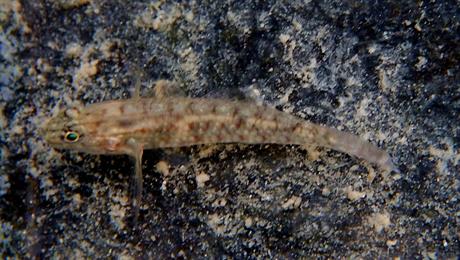




Coryphopterus glaucofraenum
| Ecological Descriptors |
||||
| Habitat | Size (cm) | Diet | Behaviour | Sex |
| Man, S, R | 8 | Cru, Wor | I | PGH |
Notes:
Three very similar looking Sand Gobies ("Bridled Goby Complex") have fairly recently been split into 3 different species (hence some books and web resources are out of date on this issue), with small differences seen in external markings and some habitat differences, though the latter can overlap and are not rigidly set in stone. The 3 species are now:
Bridled Goby: Coryphopterus glaucofraenum
Sand Canyon Goby: C. boi
Patch Reef Goby: C. tortugae
See comparative table and images of various Sand Gobies (Coryphopterus spp) HERE
Description:
Usually 2 spots at base of tail (can be joined as a "dumbell"). A row of ~4 white spots behind eye, the second one being elevated. White "bridle" from rear of mouth to edge of gill cover with darkish band above the anterior. Dark spots on top of head. Pale to translucent body (depending upon background). No orange or dark spot(s) at base of pectoral fin. White spots/ speckles on body, plus "X" shaped brown crosses..
Ecology
Shallow water, rarely deeper than 5m (15ft) in mangroves, silt, sand and in sand around patch reefs.
Life Cycle:
Oviparous, demersal spawner. Species of this genus are sequential protogynous hermaphodites, maturing as females and later changing sex to male. Both male and female spawn with many individuals in small contiguous territories
* Notes:
Since so similar to Sand Canyon, Colon and Patch Reef Goby due to paling of this complex obscuring markings, habitat/ depth may give a heuristic guide.
Three very similar looking Sand Gobies ("Bridled Goby Complex") have fairly recently been split into 3 different species (hence some books and web resources are out of date on this issue), with small differences seen in external markings and some habitat differences, though the latter can overlap and are not rigidly set in stone. The 3 species are now:
Bridled Goby: Coryphopterus glaucofraenum
Sand Canyon Goby: C. boi
Patch Reef Goby: C. tortugae
See comparative table and images of various Sand Gobies (Coryphopterus spp) HERE
Description:
Usually 2 spots at base of tail (can be joined as a "dumbell"). A row of ~4 white spots behind eye, the second one being elevated. White "bridle" from rear of mouth to edge of gill cover with darkish band above the anterior. Dark spots on top of head. Pale to translucent body (depending upon background). No orange or dark spot(s) at base of pectoral fin. White spots/ speckles on body, plus "X" shaped brown crosses..
Ecology
Shallow water, rarely deeper than 5m (15ft) in mangroves, silt, sand and in sand around patch reefs.
Life Cycle:
Oviparous, demersal spawner. Species of this genus are sequential protogynous hermaphodites, maturing as females and later changing sex to male. Both male and female spawn with many individuals in small contiguous territories
* Notes:
Since so similar to Sand Canyon, Colon and Patch Reef Goby due to paling of this complex obscuring markings, habitat/ depth may give a heuristic guide.



322



Bridled Goby


611
Bridled Goby

